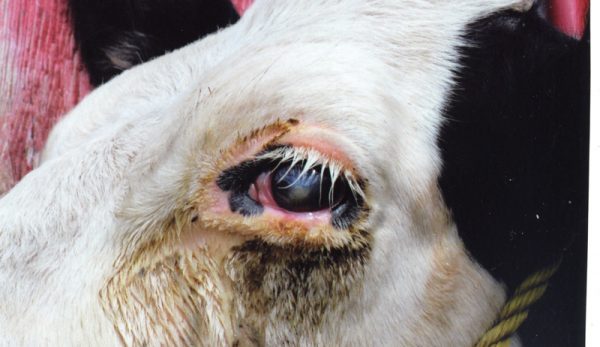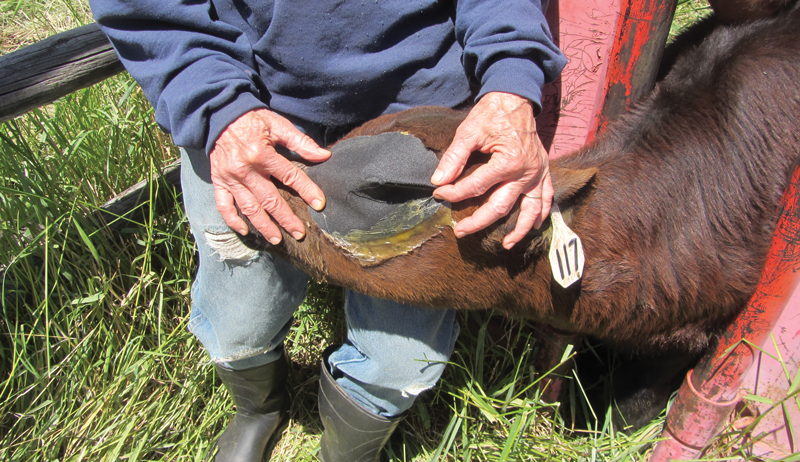
Pinkeye (infectious bovine keratoconjunctivitis) in cattle results in reduced appetite because of pain, lower weight gains in affected animals and drop in milk production.
Severe cases permanently damage the eye or rupture it, causing blindness.
Causes
Bacteria (Moraxella bovis and sometimes Moraxella bovicoli) commonly causes pinkeye. Any breed can suffer from pinkeye, but cattle with white around their eyes are more at risk because the light color reflects more ultraviolet rays into the eyes.
Pinkeye is contagious. It can be transmitted by nose-to-nose contact, fluid from the eye or rubbing the face on another animal.
Face flies carry it from animal to animal and also irritate the eyes, making the animal more vulnerable. These flies have sharp microscopic “teeth” on the end of their tongue to scrape the eye, making it water. Then they can feed on the protein-rich eye secretions.
Pinkeye bacteria gain access to the eye via the tiny wounds in the cornea caused by the face fly.
This is why pinkeye is more common when flies are present or when grass is tall (rough forage or seed heads brushing the eyeball), conditions are dusty or there is more sunlight to create corneal inflammation.
Read more: These tips will help you control flies and protect your animals.
Clinical Signs
The first thing you might notice is squinting, sensitivity to sunlight and excessive tears. If you catch it at that stage, treatment is very effective. The infection clears quickly, and you avoid damage to the eye.
The next signs—after the eye has been sensitive and watering a few days—include haziness or cloudiness of the eye. There may also be a hole/ulcer in the surface of the eyeball.
If left untreated, the ulcer may become larger and deeper. Tissue may protrude from that hole. The bulging area may grow red.
The end stage is when the eyeball—if the ulcer goes completely through the tissue, but most often it ruptures due to trauma. The animals can’t see and may run into something, or another animal hits them.
The eyeball is weak at that spot and may rupture when bumped.
Treatment
Some cases resolve without treatment, before they get to the point of deep ulceration. After healing, the eyeball clears (if it was blue/cloudy) but may have a white spot of scar tissue where the ulcer was located.
Scars on the cornea may become smaller over time and go away. Or they may remain for the rest of the cow’s life.
Systemic Antibiotics
Systemic antibiotics resolve this disease quickly if given in early stages. There are several injectable antibiotics labeled for pinkeye, but some are sold by prescription only by a veterinarian. Any of these work well, especially in early stages when the eye is simply irritated and watering—without much damage yet to the eyeball.
Injectable antibiotics reach high levels in the tears when given systemically (into the muscle or under the skin), and the tears bathe the eyeball with antibiotics. This is more effective than topical medications (squirted into the eye) that are quickly washed out by the tears. An eye affected by pinkeye produces a lot more tears because of the pain and irritation than a normal, healthy eye.
Read more: Here are some tips for properly managing your livestock medications.
Less Effective
Old treatments such as antibiotic powders do more harm than good. They cause a lot of irritation and are also quickly washed out of the eye. There are also some home remedies that may be counterproductive.
An antibiotic ointment for eye infections would work, but to be effective, it needs to be applied four times a day. Some veterinarians inject medication into the inner surface of the eyelid.
Penicillin is commonly used, sometimes mixed with a steroid to help reduce pain and inflammation. Injected medication under the inner surface of the eyelid keeps leaking out, bathing the eyeball with antibiotic.
Best Course
Treating the animal systemically with antibiotics is probably easiest. It doesn’t matter which method you use, as long as you treat the animal before serious damage occurs.
If the eyeball ruptures, the eye can’t be saved. But eyes with deep ulcerations can eventually heal, especially if you are protecting the eye.
Some veterinarians suture the eyelids together, to keep the eye closed/protected. Others pull the third eyelid across the eyeball and suture it there. Either method can happen on the farm, with the cow restrained in a chute, to protect the eyeball from trauma and injury, sunlight, dust, etc.
Glue-on eye patches may help if they don’t come off.
Prevention
Try to limit things that make cattle vulnerable to pinkeye, such as tall weeds, flies and dust. If cattle are in a corral during dry and dusty conditions, sprinkling the corral to eliminate dust can help.
Fly control with insecticide ear tags can often reduce face flies. Mowing tall portions of a pasture can help prevent irritation from rough seed heads and tall weeds.
Vaccines for pinkeye are not very effective. There are different strains of Moraxella bovis, and the one in your herd may not be the one in the vaccine. To have any efficacy, vaccines must be given before summer, and require two doses.
Some people try an autogenous pinkeye vaccine, created from samples taken from infected eyes of cattle in their herd. This would logically be most effective. But by the time you are having cases, it’s likely too late to create the vaccine to protect the rest of the herd.
This article originally appeared in the November/December 2020 issue of Hobby Farms magazine.




